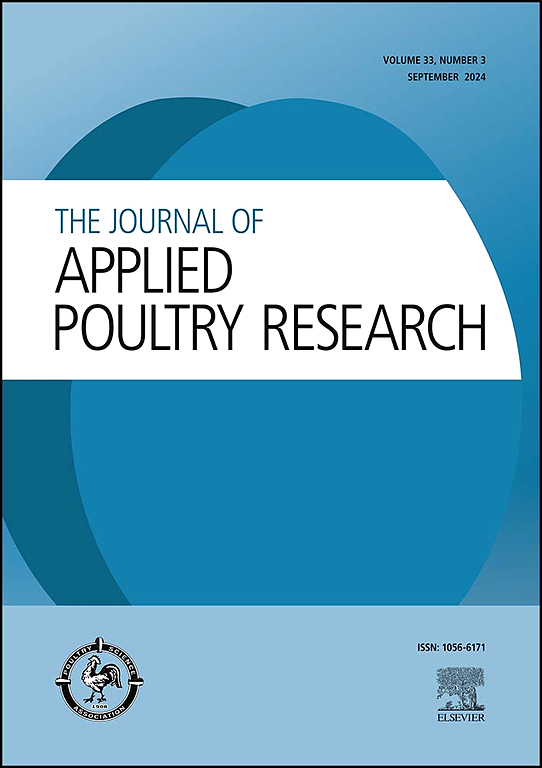Effect of sacha inchi oil (Plukenetia volubilis) on productive performance, egg quality and blood biochemistry of laying hens
IF 2
3区 农林科学
Q2 AGRICULTURE, DAIRY & ANIMAL SCIENCE
引用次数: 0
Abstract
The benefits of omega-3 (ω-3) polyunsaturated fatty acids (PUFA) are regaining importance in the growth, health and immunology of humans and animals. Sacha inchi (Plukenetia volubilis L.) is rich in PUFA, but has rarely been used to produce fortified foods. The objective of the study was to evaluate the effect of the inclusion of P. volubilis oil in diets on the production, quality, fatty acid profile, blood biochemistry and sensory aspect of hen eggs. 150 brown Hy-line hens 32 weeks old were distributed in 5 treatments: 0 % (control diet), 1 %, 2 %, 2 %, 3 % and 4 % P. volubilis oil, with 10 replicates consisting of 3 birds per cage. P. volubilis oil did not affect the productive parameters and physical quality of the egg, except for the color space a*. A reduction in the levels of omega-6 PUFA (ω-6) specifically linoleic acid (LA) and an increase of those (ω-3) were observed in egg yolk; especially alpha-linolenic (ALA), eicosapentaenoic (EPA) and docosahexaenoic (DHA) acids (P < 0.001). The addition of 4 % P. volubilis oil reduced the ratio of ω-6/ω-3 to 2.69 and the addition of 1 % reported a deposition rate of 250 mg/yolk of ω-3 (ALA, EPA and DHA). The addition of P. volubilis oil in hen diets did not affect their productive characteristics and physical egg quality, but it did influence the enrichment with ω-3 in egg yolk. This could serve as an efficient strategy to improve animal health and produce functional eggs for consumers.
沙棘油对蛋鸡生产性能、鸡蛋质量和血液生化的影响
ω-3(ω-3)多不饱和脂肪酸(PUFA)在人类和动物的生长、健康和免疫学方面的益处正重新受到重视。沙棘(Plukenetia volubilis L.)富含多不饱和脂肪酸,但很少用于生产强化食品。本研究的目的是评估在日粮中添加卷柏油对鸡蛋产量、质量、脂肪酸组成、血液生化和感官方面的影响。将 150 只 32 周龄的褐线母鸡分成 5 个处理:0 %(对照组日粮)、1 %、2 %、2 %、3 % 和 4 % 的伏鸟油共设 10 个重复,每个笼子 3 只鸡。除了颜色空间 a* 外,伏牛花油对鸡蛋的生产参数和物理质量没有影响。在蛋黄中观察到ω-6 PUFA(ω-6),特别是亚油酸(LA)含量降低,而ω-3 PUFA(ω-3)含量增加;尤其是α-亚麻酸(ALA)、二十碳五烯酸(EPA)和二十二碳六烯酸(DHA)(P <0.001)。添加 4 % 的 P. volubilis 油可将ω-6/ω-3 的比率降至 2.69,添加 1 % 的 P. volubilis 油可使ω-3(ALA、EPA 和 DHA)的沉积率达到 250 毫克/卵黄。在母鸡日粮中添加伏牛花油不会影响其生产特性和鸡蛋的物理质量,但会影响蛋黄中ω-3的富集。这可以作为改善动物健康和为消费者生产功能性鸡蛋的有效策略。
本文章由计算机程序翻译,如有差异,请以英文原文为准。
求助全文
约1分钟内获得全文
求助全文
来源期刊

Journal of Applied Poultry Research
农林科学-奶制品与动物科学
CiteScore
4.10
自引率
10.50%
发文量
80
审稿时长
104 days
期刊介绍:
The Journal of Applied Poultry Research (JAPR) publishes original research reports, field reports, and reviews on breeding, hatching, health and disease, layer management, meat bird processing and products, meat bird management, microbiology, food safety, nutrition, environment, sanitation, welfare, and economics. As of January 2020, JAPR will become an Open Access journal with no subscription charges, meaning authors who publish here can make their research immediately, permanently, and freely accessible worldwide while retaining copyright to their work. Papers submitted for publication after October 1, 2019 will be published as Open Access papers.
The readers of JAPR are in education, extension, industry, and government, including research, teaching, administration, veterinary medicine, management, production, quality assurance, product development, and technical services. Nutritionists, breeder flock supervisors, production managers, microbiologists, laboratory personnel, food safety and sanitation managers, poultry processing managers, feed manufacturers, and egg producers use JAPR to keep up with current applied poultry research.
 求助内容:
求助内容: 应助结果提醒方式:
应助结果提醒方式:


